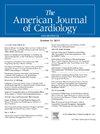心房颤动患者静息心率与死亡率之间的纵向关系
IF 2.3
3区 医学
Q2 CARDIAC & CARDIOVASCULAR SYSTEMS
引用次数: 0
摘要
心率控制在心房颤动(房颤)的治疗中起着基础性作用,但降低死亡率的最佳静息心率(RHR)目标仍不确定。本研究利用纵向随访静息心率数据评估静息心率与全因死亡率之间的关系。研究人员对 AFFIRM(心房颤动节律管理随访调查)研究的数据进行了回顾性分析。使用平均 RHR(mRHR)和个体轨迹模式对 RHR 与死亡率之间的关系进行了纵向分析,其中使用了 Cox 比例危险模型和基于组的轨迹模型。研究共纳入 3,921 名房颤患者(平均年龄为 69.47 ± 8.09 岁)。在中位 3.4 年的随访期间,共有 578 人死亡。Cox 回归分析显示,mRHR ≥80 bpm 与死亡风险增加有关(调整后危险比:2.01,95% CI:1.59-2.55)。在亚组分析中发现了一致的相关性。Kaplan-Meier 分析显示,mRHR ≥80 bpm 患者的生存概率明显降低。根据随访期间的 RHR,患者被分为四种稳定轨迹,其中大于 70 bpm 的等级与死亡风险升高有关。总之,纵向测量的RHR≥80 bpm与房颤患者的死亡风险增加有关。本文章由计算机程序翻译,如有差异,请以英文原文为准。
Longitudinal Association Between Resting Heart Rate and Mortality in Atrial Fibrillation
Rate control plays a fundamental role in the management of atrial fibrillation (AF), but the optimal target of resting heart rate (RHR) for reducing mortality remains uncertain. This study used longitudinal follow-up RHR data to evaluate the relation between RHR and all-cause mortality. Data from the Atrial Fibrillation Follow-up Investigation of Rhythm Management (AFFIRM) study were retrospectively analyzed. The association between RHR and mortality was longitudinally analyzed using mean RHR (mRHR) and trajectory patterns, where the Cox proportional hazards model and group-based trajectory model were used. A total of 3,921 patients (mean age, 69.47 ± 8.09 years) with AF were included in our study. A total of 578 deaths were recorded during a median follow-up of 3.4 years. Cox regression analyses showed an mRHR ≥80 bpm was associated with an increased risk of mortality (adjusted hazard ratio: 2.01, 95% confidence interval 1.59 to 2.55). Consistent association was found in the subgroup analyses. The Kaplan-Meier analysis showed notably reduced survival probabilities for patients with mRHR ≥80 bpm. Patients were classified into 4 stable trajectories based on RHR during follow-up, with the classes >70 bpm associated with an elevated risk of mortality. In conclusion, longitudinally measured RHR ≥80 bpm was associated with an increased risk of mortality in patients with AF.
求助全文
通过发布文献求助,成功后即可免费获取论文全文。
去求助
来源期刊

American Journal of Cardiology
医学-心血管系统
CiteScore
4.00
自引率
3.60%
发文量
698
审稿时长
33 days
期刊介绍:
Published 24 times a year, The American Journal of Cardiology® is an independent journal designed for cardiovascular disease specialists and internists with a subspecialty in cardiology throughout the world. AJC is an independent, scientific, peer-reviewed journal of original articles that focus on the practical, clinical approach to the diagnosis and treatment of cardiovascular disease. AJC has one of the fastest acceptance to publication times in Cardiology. Features report on systemic hypertension, methodology, drugs, pacing, arrhythmia, preventive cardiology, congestive heart failure, valvular heart disease, congenital heart disease, and cardiomyopathy. Also included are editorials, readers'' comments, and symposia.
 求助内容:
求助内容: 应助结果提醒方式:
应助结果提醒方式:


